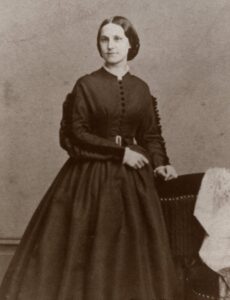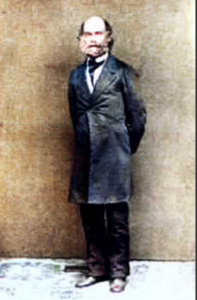

Eliza and Augustus Leggett were Quakers from abolitionist families in New York and well connected to prominent abolitionists and journalists Edward Hopper, Lucretia Mott, and William Cullen Bryant. In 1853, the Leggetts moved to Waterford, where they sheltered freedom seekers on their farm. After moving to Detroit in 1864, they worked with abolitionists Laura Haviland and Sojourner Truth to raise funds for the Underground Railroad. After the Civil War, they actively supported the Detroit Freedmen’s Society and other causes. In 1885 Augustus died and Eliza returned to Waterford. She died in 1900. Both Leggetts are buried in Oak Hill Cemetery.

Eliza Seaman Leggett is usually remembered for her work later in her life on women’s suffrage. A closer look, however, reveals her earlier activism in Michigan’s anti-slavery movement from the 1850s until the Reconstruction period after the Civil War.
Although dedicated to raising her sizable family at the time, Eliza Leggett played a significant role in the Underground Railroad network in Oakland County during the 1850s. Although they had moved here from New York, the Leggetts maintained strong ties to their abolitionist families and friends there. They were also in close contact with their Quaker relatives in southeast Michigan who were actively involved as well.
The Leggetts had purchased several parcels around the former village of Clintonville, including farmland, orchards, and a mill. Their properties were situated near the Saginaw Road and on other routes that connected to nearby abolitionist communities, making it possible to give shelter to traveling freedom seekers. In 1864, however, they moved to Detroit due to Augustus’ declining health, where they continued their work.

Their son Mortimer Leggett later described the Seaman family legacy of sheltering freedom seekers in New York as early as the 1820s, and how Eliza and Augustus continued to work in the anti-slavery movement after relocating to Oakland County during the Underground Railroad era. In a later account, Mortimer Leggett described how his mother sheltered freedom seekers on their farm in Drayton Plains, despite knowing that doing so was against the law. The farm was located in a strategic spot along major roads that connected with other Quakers in the Farmington area to the south, and that led both east to Pontiac and north to Flint.

The Leggetts also worked for years during and after the Civil War to help formerly enslaved people achieve personal liberty and settle into new lives. They worked closely with other activists such as Laura Haviland and Sojourner Truth to raise funds for these causes from their home in Detroit. After Augustus died in 1885, however, Eliza returned to Drayton Plains to continue her work from her son Mortimer’s home, known as “The Willows.” She actively corresponded with her colleagues in causes of social justice until her death in 1900. She is buried with her husband and other Leggett family members in Oak Hill Cemetery in Pontiac.

More Information
In her work to raise funds for Detroit’s Freedmen Society (aka Commission), Eliza Leggett wrote to Abraham Lincoln in February of 1865 pleading for his support in the form of verbal mention or donation to raise awareness and help the cause. The letter is preserved with his papers and available through the Library of Congress.
Acknowledgements
Primary research by Donna Casaceli, Birmingham Museum
Narrative by Leslie Pielack, Birmingham Museum
- Leggett, Eliza Seaman. Courtesy Detroit Historical Society biographical collection, (2013.048.650) ↩︎
- Leggett, Augustus Wright. Uploaded 12/19/2013 by Ancestry.com member jtjc. Augustus W. Leggett (ancestry.com). Accessed 10/7/2024. ↩︎
- “Mortimer A. Leggett,” Uploaded to FindAGrave by Ray Henry, 2/11/2011. Photos of Mortimer Allen Leggett – Find a Grave Memorial. Accessed 10/7/2024. ↩︎
- Photo image of Leggett House courtesy Detroit Public Library Digital Collections, https://digitalcollections.detroitpubliclibrary.org/islandora/object/islandora%3A149165. ↩︎